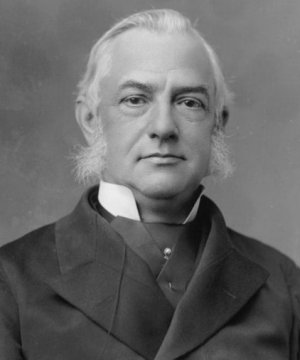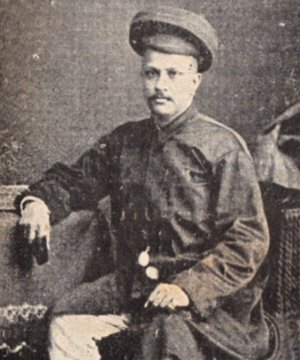| Library / Biographies |
Atal Bihari Ghose / Arthur Avalon Biography

Atal Bihari Ghose Atal Bihari Ghose was born in 1864 in a traditionally Śākta Bengali middle-class family and lived in Calcutta. He received the typical English education and graduated at Ripon College with a degree in Philosophy and English.
After that he studied Law and practiced as a lawyer (vakil) at the Alipore district court and the Court of Small Causes in Calcutta.
Ghose was a disciple of Śivacandra Vidyārṇava, a tantric saint and of Bhairavī Jayakāli Devi. He is thought to have practiced tantric sadhana on the cremation grounds of Birbhum and Bankura with Mṛtyuñjaya Vidyālankara, a Sanskrit pandit and later a saṃnyāsin. Also, Pandit Pañcānan Bhattacharya, a famous expert on Tantra who edited two of the Tantrik Text of Arthur Avalon, was his mentor in later years.
Baśumati Journal credited Ghose with the establishing of Āgamānusandhana Samiti (Āgamas Research Society). Through his work as a lawyer, Ghose met Sir John Woodroffe, the famous High Court judge with whom he will collaborate in translating and editing numerous texts on Tantra.
Most of the books the two men worked together were published by Āgamānusandhana Samiti under the pseudonym of Arthur Avalon, a name that would combine the high social status of Woodroffe and Ghose’s knowledge of Sanskrit.
Ghose wanted to write anonymously and for decades it was largely assumed John Woodroffe was behind the Arthur Avalon name.
In her 1998 PhD Thesis “The creation of a legendary orientalist: Sir John Woodroffe as Arthur Avalon in Calcutta,” Kathleen Taylor indicates that “In his preface to Sakti and Sakta, the first of the books to appear under his own name, Woodroffe explained that he had used the pseudonym to cover the fact that he worked with 'others', especially one anonymous person whom I identified as the Bengali Vakil and scholar Atal Behari Ghose.”
Ghose published under his own name in Bengali, including a study of the Tantric poet-saint Kamalakānta.
Ghose granddaughter, Mrs. Sumita Guha stated that: “My grandfather wrote all the books except Shakti and Shākta.”
Atal Behari Ghose mentored Glen Agassiz Bernard, father of Theos Casimir Bernard. After Glen Bernard returned to America from India, Ghose continued to write him letters with instructions and advice on Tantric Yoga practices.
He told Glen that he realized practicing concentration in “a country like yours, where everyone seems to be boiling over,” was difficult and suggested that to control the mind in meditation he should try fixing his gaze on the tip of his nose or on a speck of light while repeating his mantras. “As for prāṇāyāma,” he told him, “never exert yourself more than you can do with ease and comfort.”
Extremely influential mediator of the tantric tradition, Ghose had several European friends and students whom he instructed about Tantra. He considered that his English was “not what it ought to be” and his translations of the Tantras were defective because of that.
In another letter, Ghose wrote about his work on Kularnava Tantra: “my interpretation of the Kularnava is going to be one of which I shall be proud to the end of my days. The trouble is that I am interrupted so frequently here that I lose my thread and a lot of time having to pick them up again. As I read these passages, now I see things there which are anything but what I myself saw in them fifteen years ago. I see a wonderful way of putting the gross to illustrate the subtle workings of the mind and the way it rises to higher and yet higher spheres. There is not a single man here with whom I could discuss it. Even my Pandit who has been working with me for eighteen years is of no help…”
Ghose and Woodroffe maintained ample correspondence after Woodroffe retirement to Europe: Woodroffe looking to Ghose for doctrinal clarifications, editorial and publishing financial matters, family and personal aspects.
Ghose was also involved with the work on Tibetan texts and corresponded with Evans-Wentz who acknowledged his help and Woodroffe's in the preface to Tibetan Book of the Dead.
A letter from Evans-Wentz to Ghose in 1927 acknowledged help for Milarepa's biography too, and mentioned his forthcoming book on Tibetan Yoga and Secret Doctrines in which Ghose was taking a keen interest.
Atal Bihari Ghose, the Sanskrit scholar behind the Arthur Avalon name, died on January 12, 1936. Four days later, suffering of Parkinsons's disease, John Woodroffe dies at Beausoleil, France, near Monte Carlo.
Bengali journal Baśumati wrote: “they have gone together to the lap of the Great Mother; we hope that they would be born again in the same twin-form to spread the knowledge of the principles of Śakti.”
Books published originally under the name of Arthur Avalon and subsequently reprinted or revised under the name of Sir John Woodroffe
1913: The Great Liberation (Mahānirvāṇatantra) London, Luzacs; 6th ed. 1985, Madras, Ganesh.
1914: Principles of Tantra, vols 1 & 2, London, Luzacs; 6th ed. 1986 Madras, Ganesh.
1917: Wave of Bliss (Ānandalaharī), London, Luzacs; Greatness of Śiva (Mahimnastava of Puṣpadanta), London, Luzacs; Īśā Upanishad, with commentary of Sadānanda, London, Luzacs; Reprinted 1971 as: Īśopaniṣad, Wave of Bliss, Greatness of Śiva, Madras, Ganesh.
1918: The Serpent Power London, Luzacs. 2nd ed. 1922, Madras, Ganesh; 3rd ed. 1928, Madras, Ganesh; 14th ed. 1989, Madras, Ganesh.
1952: An Introduction to Tantra Śāstra (original introduction to MNT) Madras, Ganesh; 8th ed: 1990 Madras, Ganesh.
1954: An Introduction to the Tantrarāja Tantra, Madras, Ganesh.
The Tantrik Texts General Editor: Arthur Avalon
• Tantrābhidhāna with Bījanighaṇṭu and Mudrānighaṇṭu (Seven tantrik dictionaries with bīja and mudrā glossaries), editor: Tārānātha Vidyāratna, introduction: Arthur Avalon 1913.
• Ṣaṭcakranirūpaṇa by Purnānanda Swāmi, editor: Tārānātha Vidyāratna, introduction: Arthur Avalon, 1913.
• Prapañcasāra tantra, editor: Tārānātha Vidyāratna, introduction: Arthur Avalon, 1914.
• Kulachūdāmaṇi tantra, editor: Giriṣa Candra Vedāntatīrtha, introduction: Aksay Kumar Maitra, 1915.
• Kulārnava tantra, editor: Tārānātha Vidyāratna, introduction: Arthur Avalon, 1917.
• Kālīvilāsa tantra, editor: Pārvati Carana Tarkatīrtha, introduction: Arthur Avalon, 1916.
• Śrīcakrasambhāra tantra, editor: Kazi Dawa-Samdup, foreword: Arthur Avalon,1918.
• Tantrarāja tantra part I, editor: MMP Lakṣmaṇa Śāstri, introduction: Arthur Avalon, 1918.
• Kārpūrādistotram (Hymn to Kālī by Mahākāla) Translated by Arthur Avalon, 1922.
• Kāmakalāvilāsa of Pūnyānanda, editor: MMP Sadāśiva Miśra Translation and notes by Arthur Avalon, 1922.
• Kaulopaniṣad, Tripurāmahopaniṣad, Bhāvanopaniṣad, Bahvrīcopaniṣad, Āruṇopaniṣad, Kālikopaniṣad, editor: Śītārāma Śāstrī, introduction: Arthur Avalon, commentary: Bhāskararāya,1922.
• Tantrarāja tantra part II, editor: MMP Sadāśiva Miśra, introduction: Arthur Avalon, 1926.
• Mahānirvāṇa tantra, editor: Arthur Avalon, 1928.
• Kaulāvalī-nirṇayah (Compilation by Jñānānanda Paramahamsa), editor: Arthur Avalon, 1928.
• Brahmasaṃhitā and Viṣṇusahasranāma, editor: Arthur Avalon, 1928.
• Śāradātilaka tantra by Laksmanadeśika, editor: Arthur Avalon, introduction: Arthur Avalon, 1933.
• Prapañcasāra tantra by Śaṅkarācārya, editor: Arthur Avalon, introduction: Arthur Avalon, 1935.
• Chidgagana-chandrikā, editor: Svāmī Trīvikrama Tīrtha, introduction: Arthur Avalon, 1937.
• Tārā-bhakti-sudhārṇava, editor: Pañcānana Bhattācāryya, introduction: not signed, 1940.





